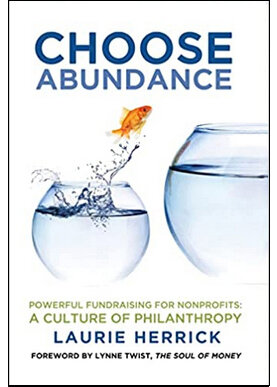Choose Abundance: Powerful Fundraising for Nonprofits — A Culture of Philanthropy
In his 1989 best-seller, The Seven Habits of Highly Effective People, Stephen R. Covey coined the terms “abundance mindset,” the belief in a benevolent world rich in resources, and “scarcity mindset,” the belief in a competitive world lacking in resources. Three decades on, most of us are still struggling to choose abundance over a scarcity mindset. Every day, we’re besieged with messages from a consumer culture that encourages the desire for new things and manifests the fear of not having enough. As Lynne Twist notes in her book, The Soul of Money, which Herrick considers required reading: “This mantra of not enough carries the day and becomes a kind of default setting for our thinking about everything, from the cash in our pocket to the people we love or the value of our own lives.” In this environment, can a nonprofit organization made up of complicated individuals choose abundance? Yes! In her book Choose Abundance: Powerful Fundraising for Nonprofits — A Culture of Philanthropy, Laurie Herrick, founder and president of Rainmaker Consulting, reveals step by step how nonprofit staff and their organizations can choose abundance by building a “culture of philanthropy” and reframing their attitudes toward fundraising.
What is a “culture of philanthropy”? After stating her preferred gender-neutral definition of philanthropy, “love of humankind,” Herrick explains, “A Culture of Philanthropy exists when organization-wide attitudes, actions and systems reflect an understanding, respect and responsibility for philanthropy’s role in the success of the organization.” In this culture, all stakeholders within the organization and in the larger community are engaged and active in advancing the cause through their individual strengths. Everyone has something to offer, whether financial assets, time, wisdom, experience, connections, or special skills. A culture based on deep relationships and a common goal opens the door to infinite possibilities.
So how do you get there? As Herrick makes clear, building a “culture of philanthropy” requires planning, patience, perseverance, and a long-term commitment. The organization’s leadership, board members, and staff from all departments must choose to work together as a team, forming authentic relationships with each other and their community of stakeholders. Investing in this new culture could take three to five years, but if a nonprofit doesn’t make that investment, what does the future hold? Once the entire organization is truly committed and motivated, writes Herrick, it’s time to start “revealing, unpacking, and dismantling” the scarcity language that limits the organization’s ability to fulfill its mission. In this culture, words matter and attitude is everything.
A detailed table of contents clearly lays out Herrick’s six-part plan for successfully building a culture of philanthropy. She suggests treating Choose Abundance as a workbook and, as such, most chapters include exercises. Herrick’s favorite resources, including articles, blogs, books, and periodicals, are collected at the end of the book; she makes use of many of these resources throughout the book, acknowledging their contribution to the creation of the “culture of philanthropy” concept. The book contains graphics and charts, which are also available as free high-quality downloads on the Book Hub at www.ChooseAbundanceBook.com. Other resources on the Book Hub include a Culture of Philanthropy Assessment, designed to evaluate a nonprofit’s culture of philanthropy right now.
Although the focus of this book is on individual giving, the concepts here are invaluable for all types of fundraising and for life in general. Imagine a world in which we routinely ask ourselves, “Am I the problem or the solution?,” and then choose to authentically become the solution. Living life in a “culture of philanthropy” is living our best life, while investing in and choosing abundance for all.
Kati Neiheisel is a senior liaison at Candid.








